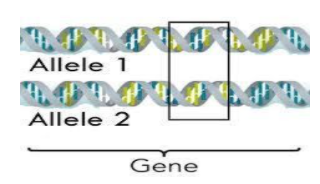
The genotype for the height of an organism is Tt. What conclusion can be drawn from this?
A. The allele for height has at least two different genes.
B. There is at least two different alleles for the gene controlling height
C. There is two different genes for height, each having a single allele
D. There is one allele for height with two different forms
Answer
496.2k+ views
Hint: When a gene is a unit of hereditary information, an allele is a variant form of a gene. An allele cannot have two genes. But a gene can have two alleles. Alleles are one pair of a gene. This appears at a particular location on the chromosomes. They control the same type of characteristic.
Complete answer:
The genetic composition of an organism is called its genotype. The genotype is also the combination of alleles it has.
There are two alleles in a single gene for each character or trait. The alleles lie on the two homologous chromosomes at the same locus.
The alleles can be homologous (representing the same expression, e.g., TT for height) or heterozygous (representing the alternate expressions, e.g., Tt for height) for the same character.
Thus for the genotype Tt, there are two alleles: T and t.

So, the correct answer is “Option B”.
Additional Information:
Genotype: They are the genes present in the DNA of an organism. A pair of letters are used to represent genotypes for a particular character or trait. E.g., Tt or TT or yy, etc.)
Phenotype: The basic features of a particular organism that are represented through its genotype. E.g., blue eyes, the color of leaves, the shape of seeds, etc.)
Alleles: These are the alternative forms of the same gene. Both the alleles of the same gene are located in a single set of homologous chromosomes.
Note:
A Punnett square would be the most efficient method in finding out the genotypes and phenotypes of successive generations of living organisms. It was derived by Reginald C. Punnett. However, understanding the basics which include the clarifications between a very common misconception of alleles and genes is a must.
Complete answer:
The genetic composition of an organism is called its genotype. The genotype is also the combination of alleles it has.
There are two alleles in a single gene for each character or trait. The alleles lie on the two homologous chromosomes at the same locus.
The alleles can be homologous (representing the same expression, e.g., TT for height) or heterozygous (representing the alternate expressions, e.g., Tt for height) for the same character.
Thus for the genotype Tt, there are two alleles: T and t.

So, the correct answer is “Option B”.
Additional Information:
Genotype: They are the genes present in the DNA of an organism. A pair of letters are used to represent genotypes for a particular character or trait. E.g., Tt or TT or yy, etc.)
Phenotype: The basic features of a particular organism that are represented through its genotype. E.g., blue eyes, the color of leaves, the shape of seeds, etc.)
Alleles: These are the alternative forms of the same gene. Both the alleles of the same gene are located in a single set of homologous chromosomes.
Note:
A Punnett square would be the most efficient method in finding out the genotypes and phenotypes of successive generations of living organisms. It was derived by Reginald C. Punnett. However, understanding the basics which include the clarifications between a very common misconception of alleles and genes is a must.
Recently Updated Pages
Master Class 11 Business Studies: Engaging Questions & Answers for Success

Master Class 11 Economics: Engaging Questions & Answers for Success

Master Class 11 Accountancy: Engaging Questions & Answers for Success

Master Class 11 Computer Science: Engaging Questions & Answers for Success

Master Class 11 English: Engaging Questions & Answers for Success

Master Class 11 Maths: Engaging Questions & Answers for Success

Trending doubts
Which one is a true fish A Jellyfish B Starfish C Dogfish class 11 biology CBSE

Difference Between Prokaryotic Cells and Eukaryotic Cells

1 ton equals to A 100 kg B 1000 kg C 10 kg D 10000 class 11 physics CBSE

One Metric ton is equal to kg A 10000 B 1000 C 100 class 11 physics CBSE

How much is 23 kg in pounds class 11 chemistry CBSE

Net gain of ATP in glycolysis a 6 b 2 c 4 d 8 class 11 biology CBSE




